Often found in supermarkets and convenience stores, Sukeroku Sushi is a familiar and comforting sight in Japan. But behind this simple sushi box lies a clever origin story rooted in a popular Kabuki play. A classic combination of inari-zushi (sushi rice in seasoned tofu pouches) and maki-zushi (sushi rolls), sukeroku sushi is a traditional Japanese dish that is naturally vegan and that everyone can enjoy. Let’s explore this beloved meal, from its Edo-period roots to how you can make it at home.
About Sukeroku Sushi
What is Sukeroku Sushi?
Sukeroku sushi is a set meal that consists of inari-zushi and maki-zushi. Unlike other sushi, the rolls do not contain seafood like tuna or salmon, but feature classic ingredients like kanpyō (seasoned gourd) and cucumber. People have cherished this combination since the Edo period as a type of fast food, and it remains one of Japan’s most beloved comfort foods today.
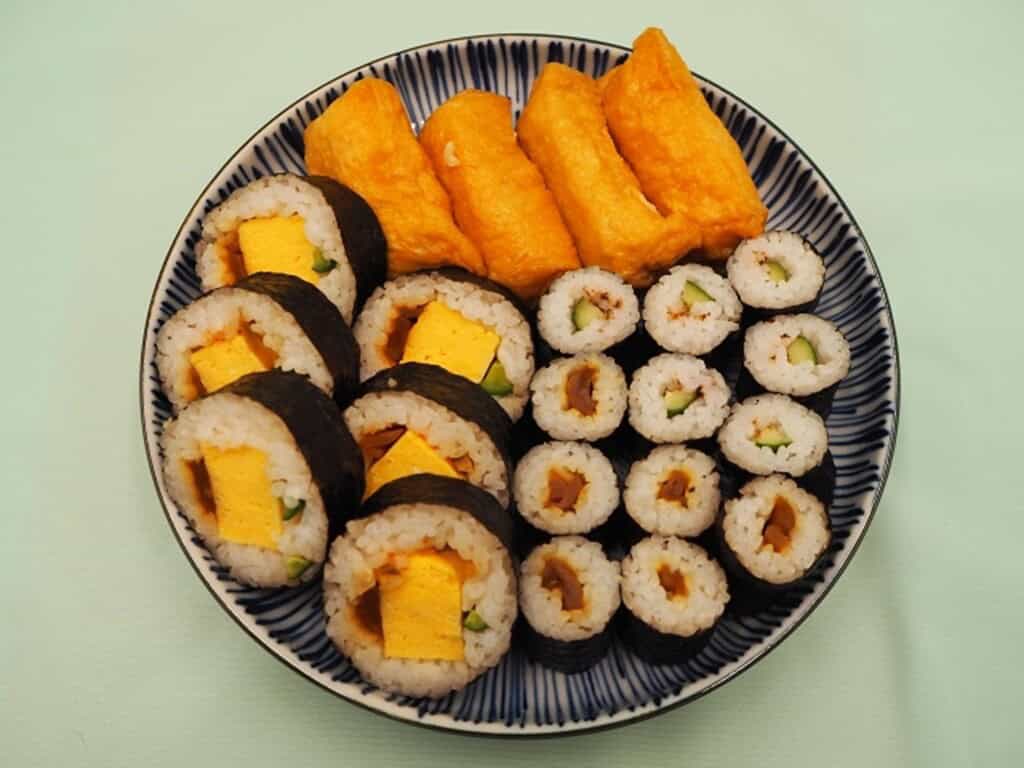
The Origin of the Name
The practice of calling this set “Sukeroku” began in the mid-Edo period. The name comes from the hero of the famous Kabuki play Sukeroku Yukari no Edo Zakura (“Sukeroku, Flower of Edo”).
In the play, Sukeroku’s lover is a famous courtesan from the Yoshiwara district named Agemaki. Then, with a clever play on words characteristic of the people of Edo, people split the name “Agemaki” into its two parts: they linked “age,” meaning fried, to the deep-fried tofu pouches of inari-zushi, while they linked “maki,” meaning roll, to the nori-wrapped maki-zushi. Ultimately, the combination of the two became known as Sukeroku Sushi, a witty tribute to the play’s hero and his lover.
Another theory suggests the name is a visual metaphor: the dark nori roll represents the purple hachimaki (headband) Sukeroku wears, while the golden tofu pouch represents the beautiful Agemaki.
The History of Sukeroku Sushi
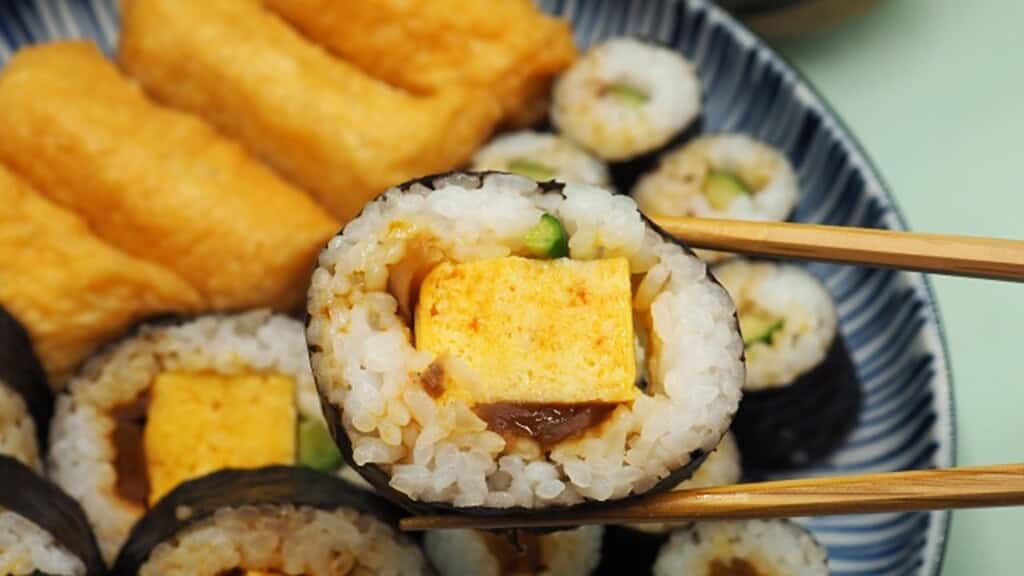
During the Edo period, authorities enacted sumptuary laws to prohibit luxury. In place of the more expensive nigiri sushi made with fresh fish from Edo Bay, the city’s commoners embraced more affordable options like inari-zushi and maki-zushi. Eventually, bento boxes containing these two items appeared and people called them “Agemaki,” based on the ingredients.
As the Kabuki play Sukeroku Yukari no Edo Zakura became a sensation, merchants, hoping to capitalize on the hero’s popularity, began calling the bento box “Sukeroku.”
The Nagoya Origin Theory
Interestingly, there is a competing theory that Sukeroku Sushi originated in Nagoya. Specifically, during the Meiji era, a performance of Sukeroku was held at a theater in Atsuta. At that time, a sponsor, looking for a summer-friendly gift for the actors that wouldn’t spoil easily, brought them a box of inari-zushi and maki-zushi. Subsequently, upon receiving it, one of the actors quipped, “With the age (fried tofu) and the maki (roll), this must be Sukeroku!”
This theory finds support in the Morisada Mankō, an Edo-period encyclopedia, which states that people first created inari-zushi in the Owari and Nagoya regions and that it gained popularity in Edo around the Tenpō era (1830–1844).
Regional Differences in Sukeroku Sushi
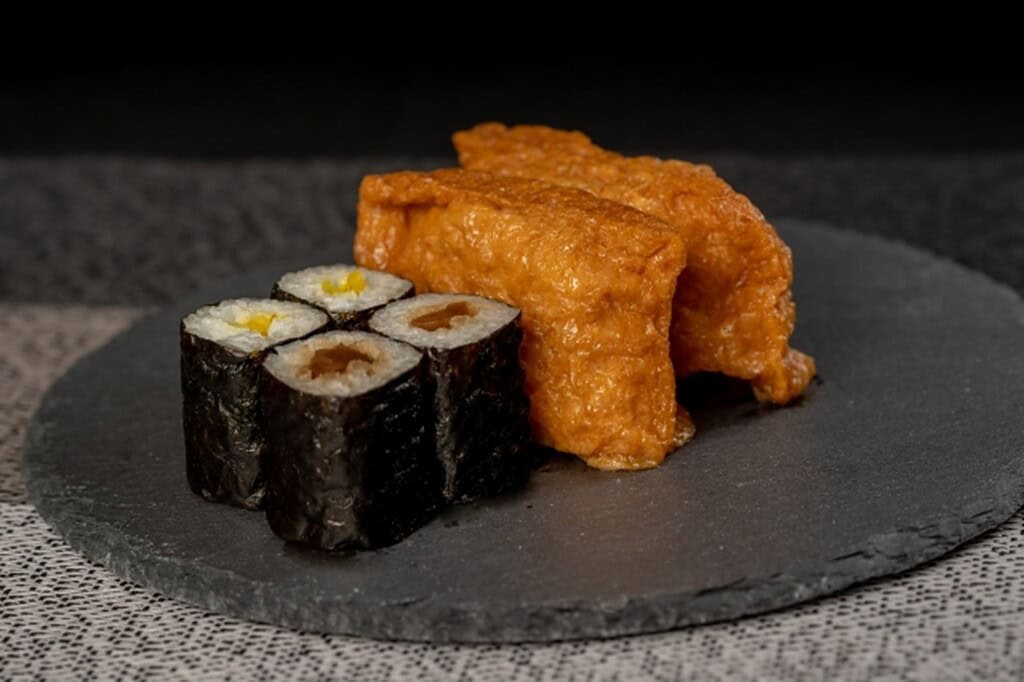
The style of Sukeroku Sushi varies by region in Japan.
Eastern Japan (Kanto)
- Rolls: Thin rolls, typically kanpyō-maki (seasoned gourd rolls).
- Inari: Rectangular or barrel-shaped pouches.
- Filling: Simple, unadorned sushi rice.
Western Japan (Kansai)
- Rolls: Thick rolls, or futomaki, with multiple fillings.
- Inari: Triangular-shaped pouches.
- Filling: Rice mixed with ingredients like carrots, burdock root, and lotus root.
In the Kansai region especially, the futomaki is so popular that many people order it on its own.
Why It’s a Great Choice for Vegans
The main reason sukeroku sushi is a fantastic vegan sushi option is that it is traditionally made entirely from plant-based ingredients.
Inari-zushi Components
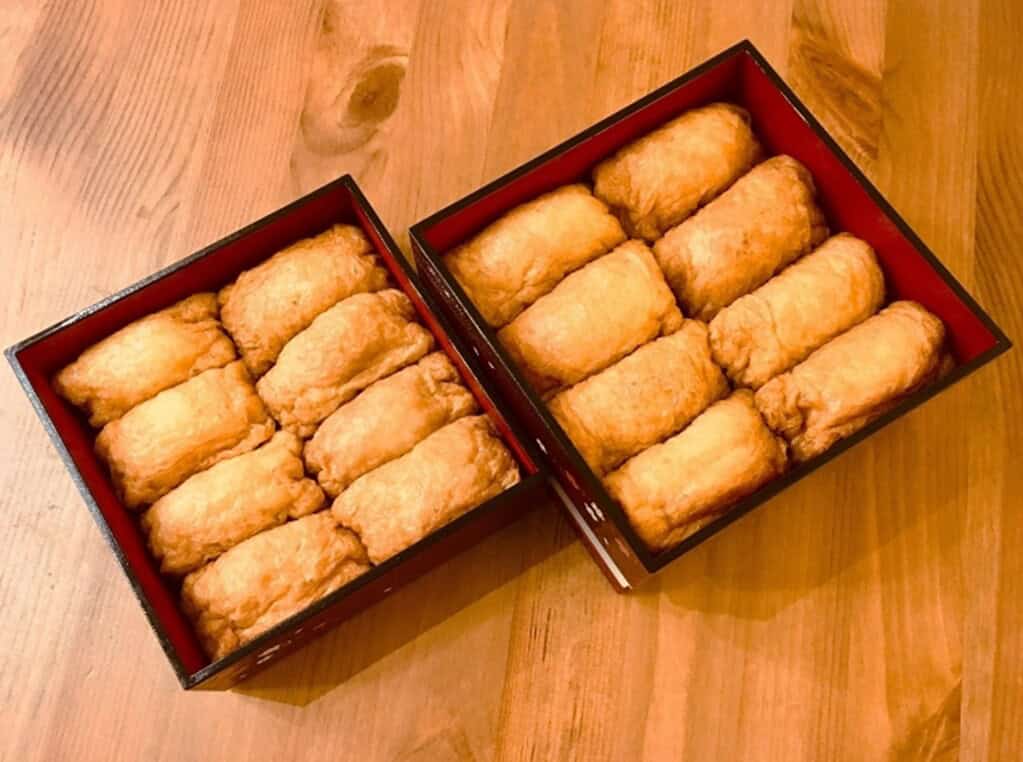
- Fried Tofu Pouch (Aburaage): A 100% plant-based product made from soybeans.
- Sushi Rice: Made only from rice, vinegar, sugar, and salt.
- Seasoning: Soy sauce, sugar, mirin, and dashi (made from kombu kelp).
Maki-zushi Components
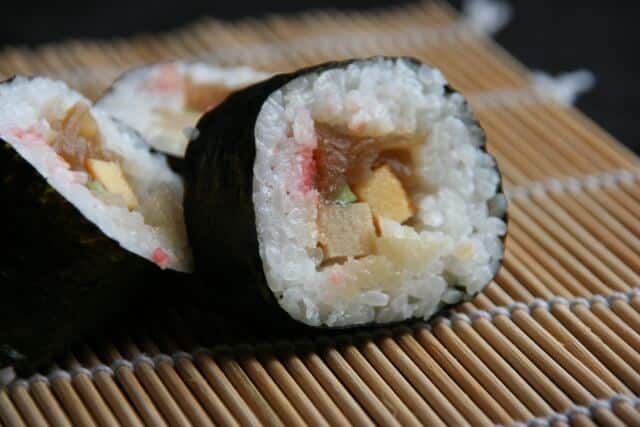
- Nori: Seaweed, a completely plant-based sea vegetable.
- Sushi Rice: Same as above.
- Fillings: Plant-based ingredients like kanpyō, cucumber, carrots, and shiitake mushrooms.
Nutritional Highlights
For those on a plant-based diet, Sukeroku Sushi is an excellent way to get key nutrients:
- Protein: High-quality protein from soybeans.
- Carbohydrates: Rice provides a great source of energy.
- Dietary Fiber: From nori and the vegetable fillings.
- B Vitamins: Help support energy metabolism.
- Minerals: Rich in iodine and molybdenum.
How to Make Sukeroku Sushi
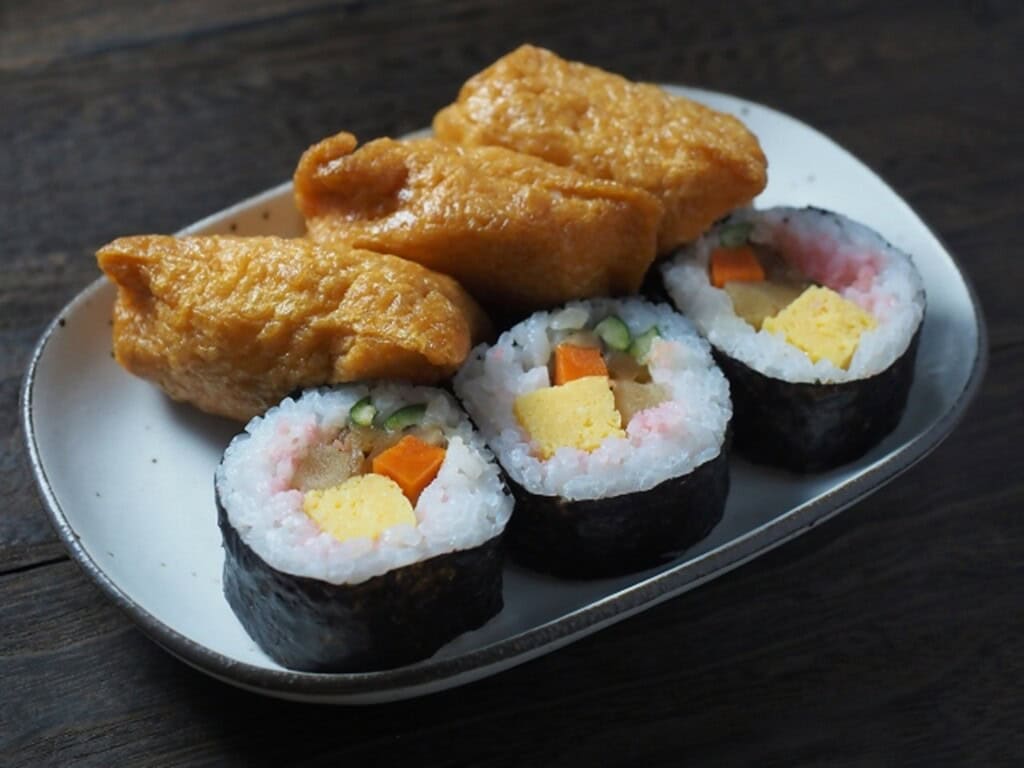
Basic Ingredients (Serves 2)
- 2 cups (Japanese rice cooker cups) of rice
- Sushi vinegar (2 tbsp rice vinegar, 1 tbsp sugar, 1 tsp salt)
- 4 aburaage (fried tofu pouches)
- 2 sheets of roasted nori
- Kanpyō (dried gourd strips), as needed
- 1 cucumber
- 2-3 shiitake mushrooms
For the Inari-zushi Seasoning
- 2 tbsp sugar
- 2 tbsp soy sauce
- 100ml dashi stock (kombu-based)
Instructions
1. Prepare the Sushi Rice
- Cook the rice. Once done, transfer to a large bowl and mix in the sushi vinegar.
- Cool the rice quickly by fanning it with a paddle or fan.
2. Make the Inari-zushi
- Blanch the tofu pouches in hot water to remove excess oil. Cut them in half to create pockets.
- Simmer the pouches in the seasoning broth for 15 minutes, then let them cool in the liquid.
- Gently stuff the pouches with sushi rice and fold the opening to close.
3. Make the Maki-zushi
- Rehydrate and season the kanpyō and shiitake mushrooms according to package directions.
- Place a sheet of nori on a bamboo rolling mat and spread a thin, even layer of sushi rice on top, leaving a small border at the far edge.
- Arrange your fillings (kanpyō, cucumber, etc.) in a line across the center.
- Roll the sushi tightly from the front edge.
- Cut the roll into bite-sized pieces with a sharp, wet knife.
Nutrition Facts
The approximate nutritional content for a standard serving of Sukeroku Sushi (4 inari pieces + 4 maki pieces, approx. 422g):
| Nutrient | Amount |
| Calories | 641 kcal |
| Protein | 20.09 g |
| Fat | 20.13 g |
| Carbohydrates | 97.74 g |
| Dietary Fiber | 2.74 g |
| Sodium | 2.19 g (5.57g salt equivalent) |
It is particularly rich in iodine and molybdenum, which are crucial for maintaining immune function and providing antioxidant benefits.
Health Benefits
This delicious vegetarian sushi set may also offer several health benefits:
- Immunity Boost: From protein, vitamin A, and vitamin E.
- Fatigue Recovery: B vitamins support energy metabolism.
- Cancer Prevention: The antioxidant properties of molybdenum and selenium.
- Anemia Prevention: Iron and vitamin B12 contribute to red blood cell production.
- Skin Health: Niacin helps improve blood circulation.
Recommended Sukeroku Sushi Shops
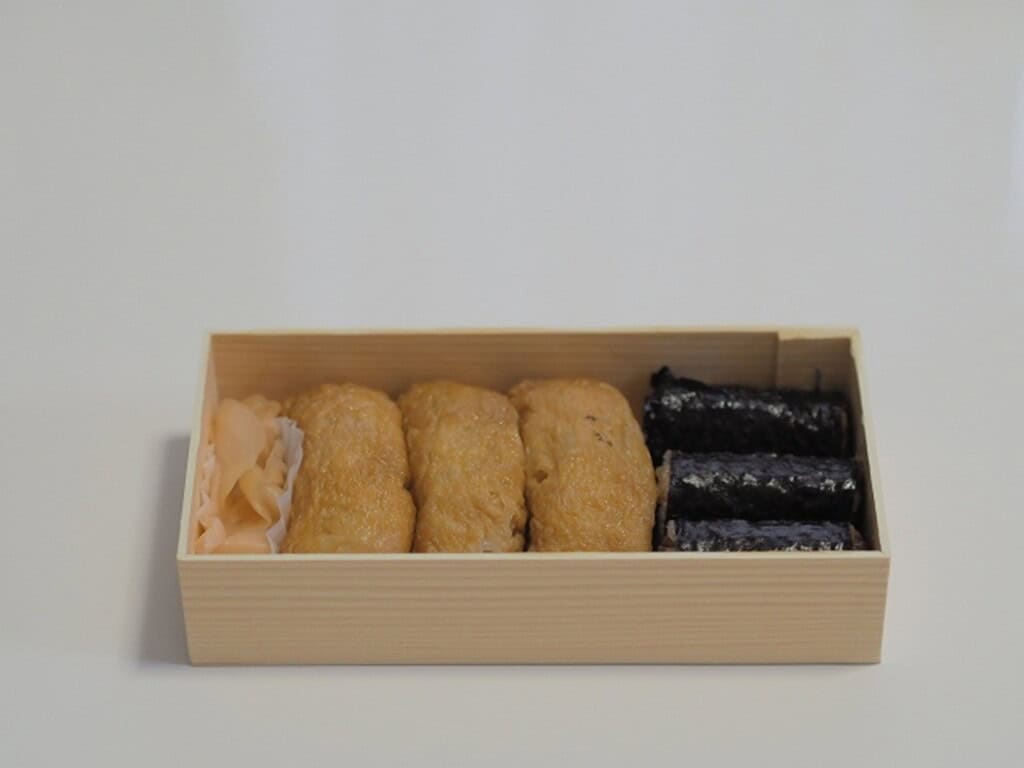
Tokyo
Shinoda-zushi Sohonten (Ningyocho)
An iconic inari-zushi specialist founded in 1877. They use a unique “two-stage simmering method” where they simmer custom-made thick tofu pouches once, age them for several days, and then simmer them again with a blend of three types of sugar, soy sauce, and mirin. This creates an incredibly fluffy and deeply flavorful result. Their kanpyō rolls and seasonal pressed sushi are also popular.
Kanda Shinoda Sushi (Awajicho)
Established in 1902, this shop is famous for its perfectly balanced Sukeroku, featuring less-sweet rice that complements the richly simmered tofu and kanpyō. You can also eat in their basement dining area, making it a great spot for a quick breakfast or light lunch. It opens at 7:30 AM, attracting regulars who want their sushi fresh.
Kyoto
Nakamuraya Sukeroku Sushi Shop (Demachiyanagi)
A takeout-only shop near Demachiyanagi Station. Their Sukeroku must be reserved by the previous day. While the combination of sweet tofu pouches and thick rolls is simple, however, the quality of the ingredients and meticulous preparation make it an exceptional treat. Thus, it’s a hidden gem beloved by locals more than tourists.
Izuu (Gion-Shijo)
A renowned Kyoto-style sushi restaurant with a history of over 100 years. Their Sukeroku set, featuring yuzu-scented inari and delicate maki rolls, is celebrated for its elegant and refreshing aftertaste. You can get it for takeout or enjoy it inside the restaurant, which has an atmosphere that reflects Gion’s refined culture.
Relation to Other Japanese Cuisine
Like nabemono (one-pot dishes) such as sukiyaki, shabu-shabu, and oden, Sukeroku Sushi similarly represents a form of humble, everyday cuisine that uses simple cooking methods and accessible ingredients. As such, it belongs to a food culture that families and friends enjoy together.
Furthermore, because it contains entirely plant-based ingredients, Sukeroku Sushi also offers a sustainable and environmentally friendly choice that aligns perfectly with modern dietary values.
Conclusion
Sukeroku Sushi is a traditional Japanese meal with a witty name born from the world of Kabuki theater. Because it is made exclusively from plant-based ingredients, it is a delicious and satisfying option for vegans and vegetarians.
Its components—inari-zushi made from soy and rice, and maki-zushi made from seaweed and vegetables—are simple yet nourishing. It’s an excellent food for efficiently consuming high-quality protein, carbohydrates, vitamins, and minerals.
By understanding the cultural history behind this beloved dish, you can deepen your appreciation for Japan’s rich culinary traditions. As a meal that has been loved for centuries and fits seamlessly into the modern demand for sustainable food, Sukeroku Sushi remains an ideal choice for everyone.
FAQ
FAQ of Sukeroku zushi
- What is Sukeroku sushi?
It’s a traditional Japanese sushi combining inari sushi and futomaki (thick rolled sushi).
- What is the origin of its name?
It’s named after a character from the kabuki play “Sukeroku Yukari no Edo Zakura.”
- When is it typically eaten?
It’s commonly eaten during cherry blossom viewing, sports days, memorial services, and as part of everyday meals.
- Can it be carried around?
It can be carried at room temperature for short periods, but using a cooler is recommended for longer durations.
- How should it be stored?
Best eaten the same day. Refrigeration hardens the vinegared rice, so wrap it in plastic and consume quickly.

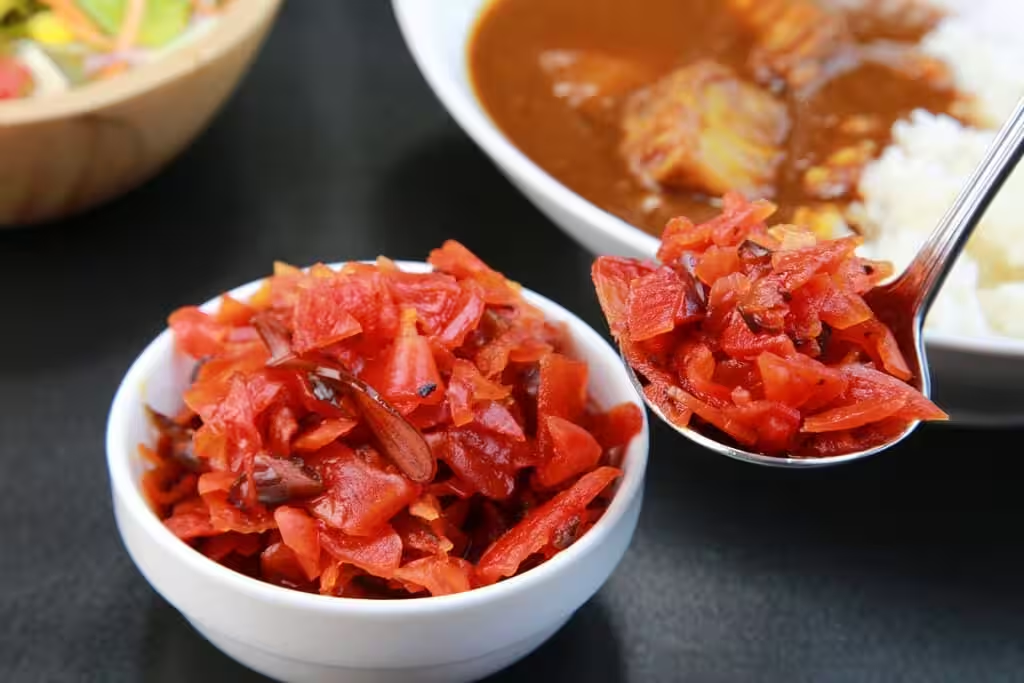
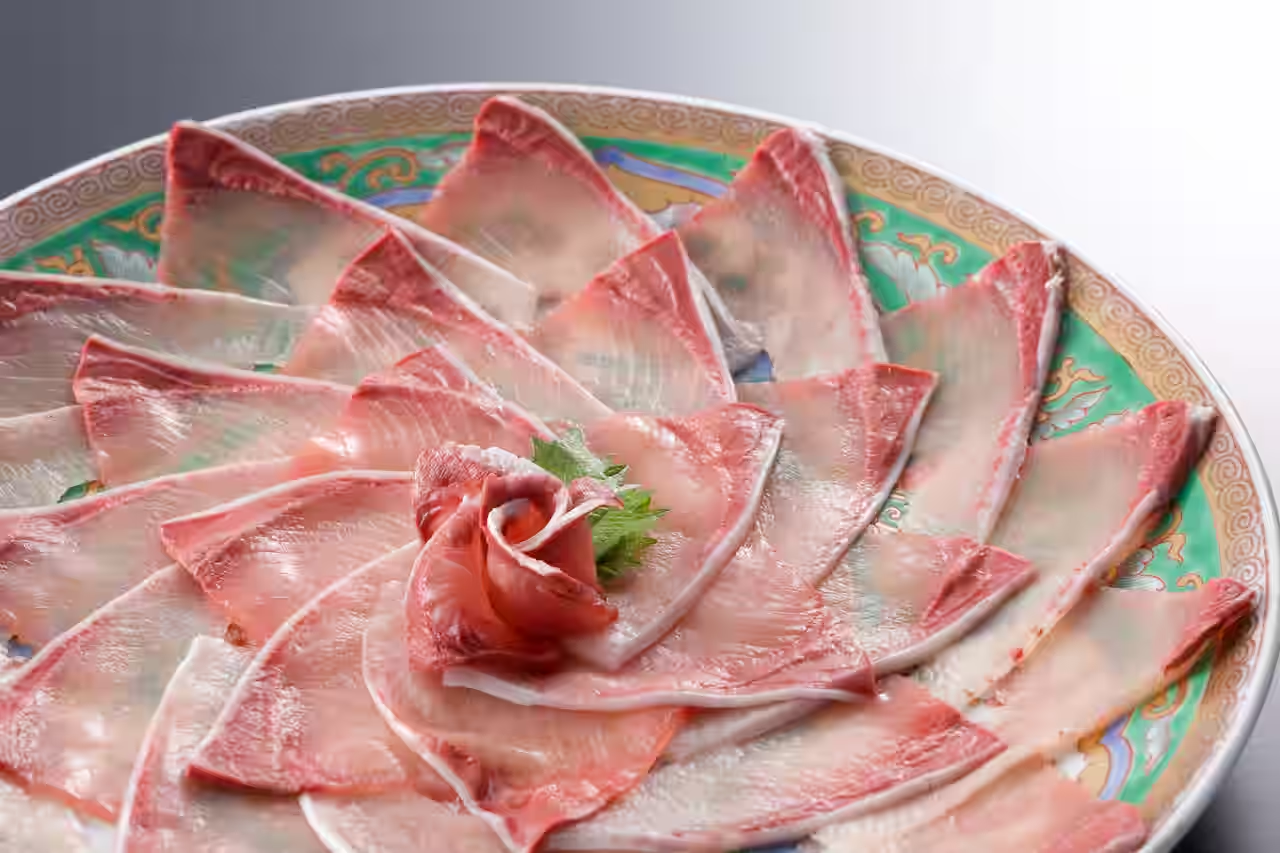
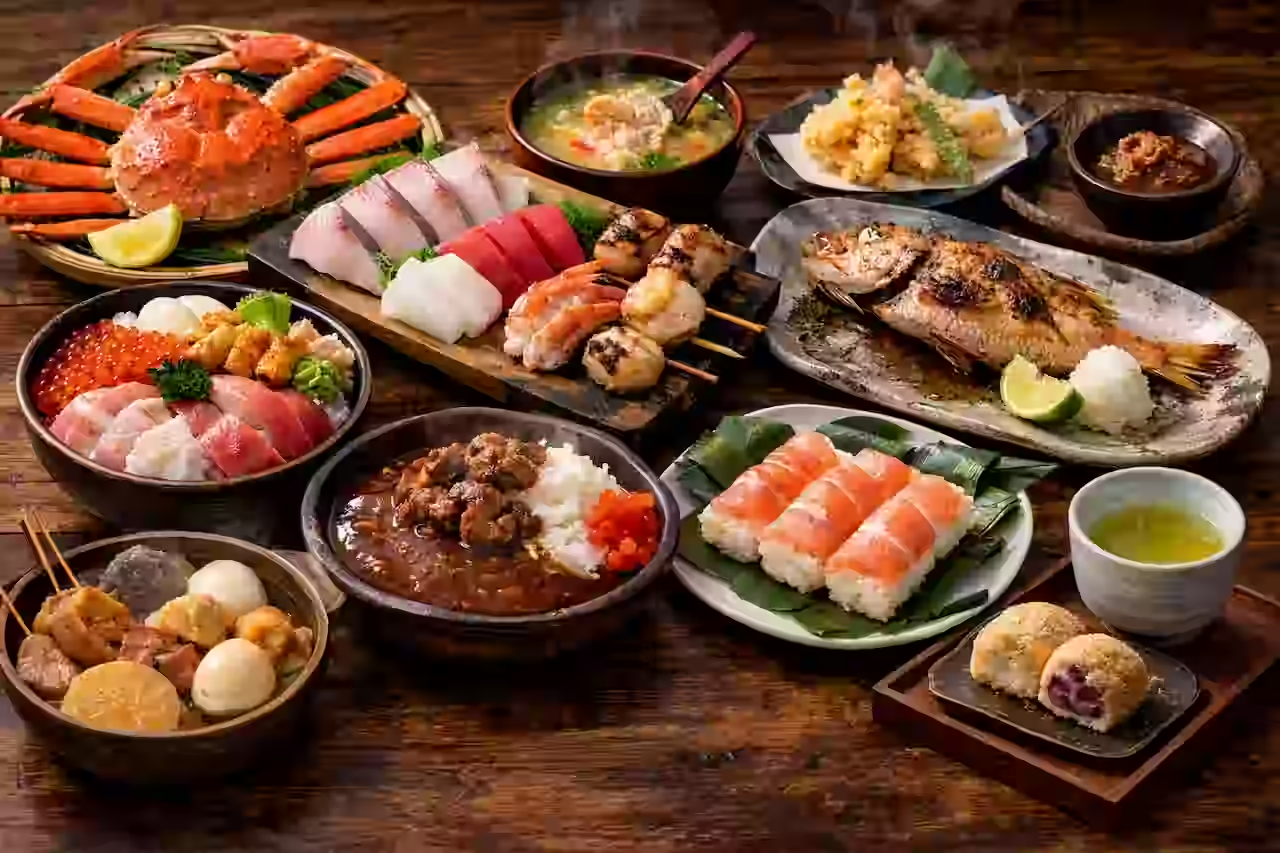
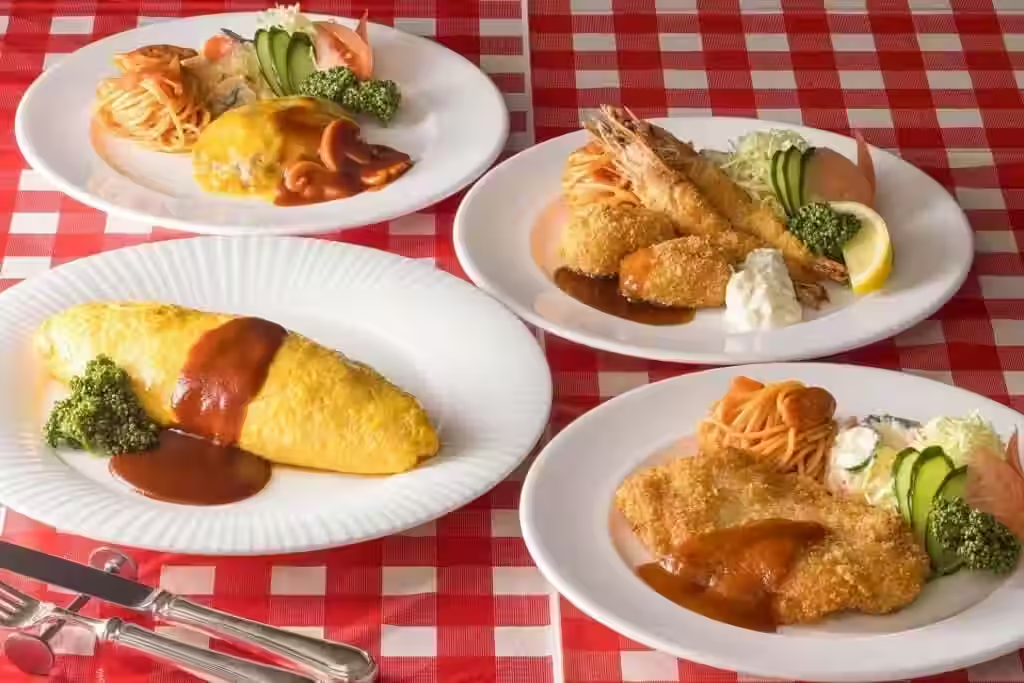

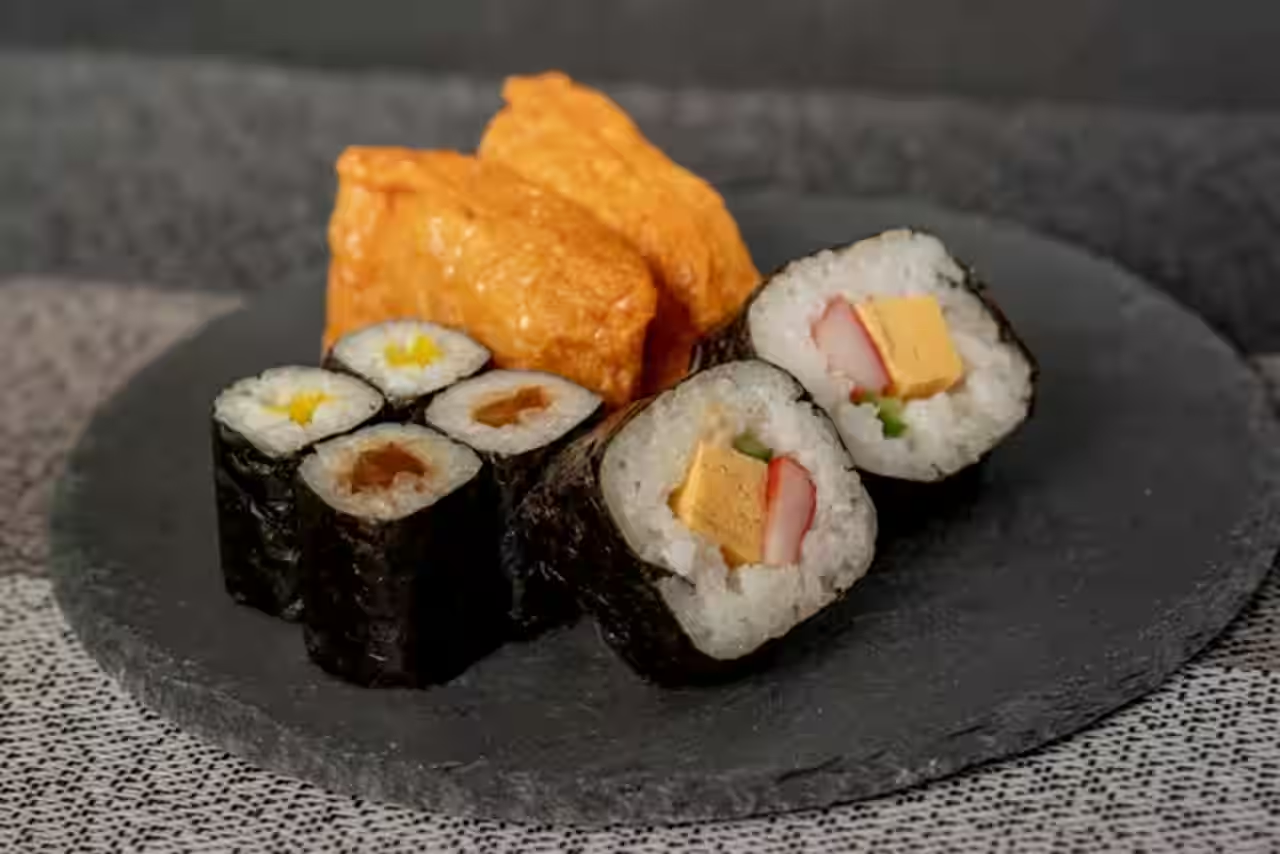
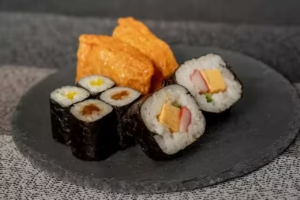
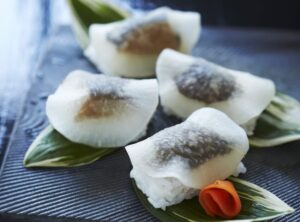

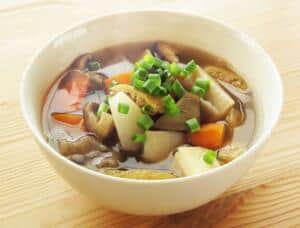
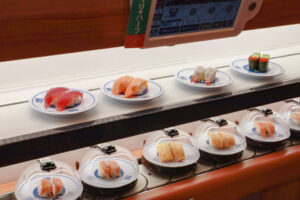
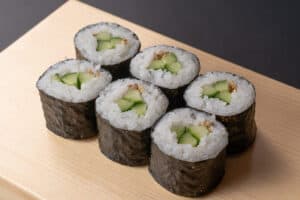
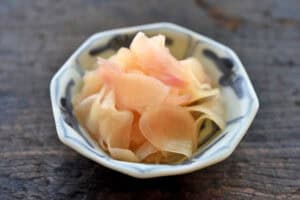
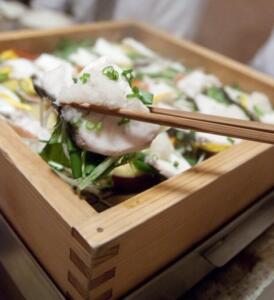
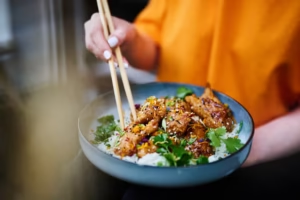
Comments